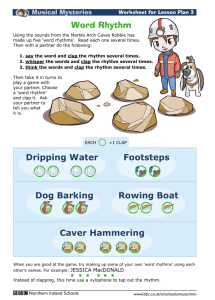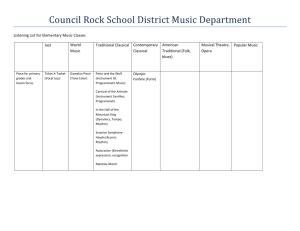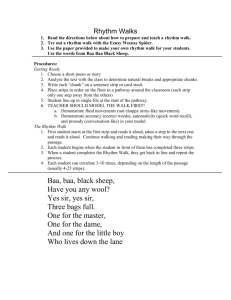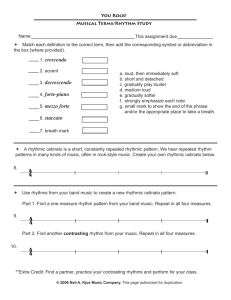Teacher Comments
advertisement
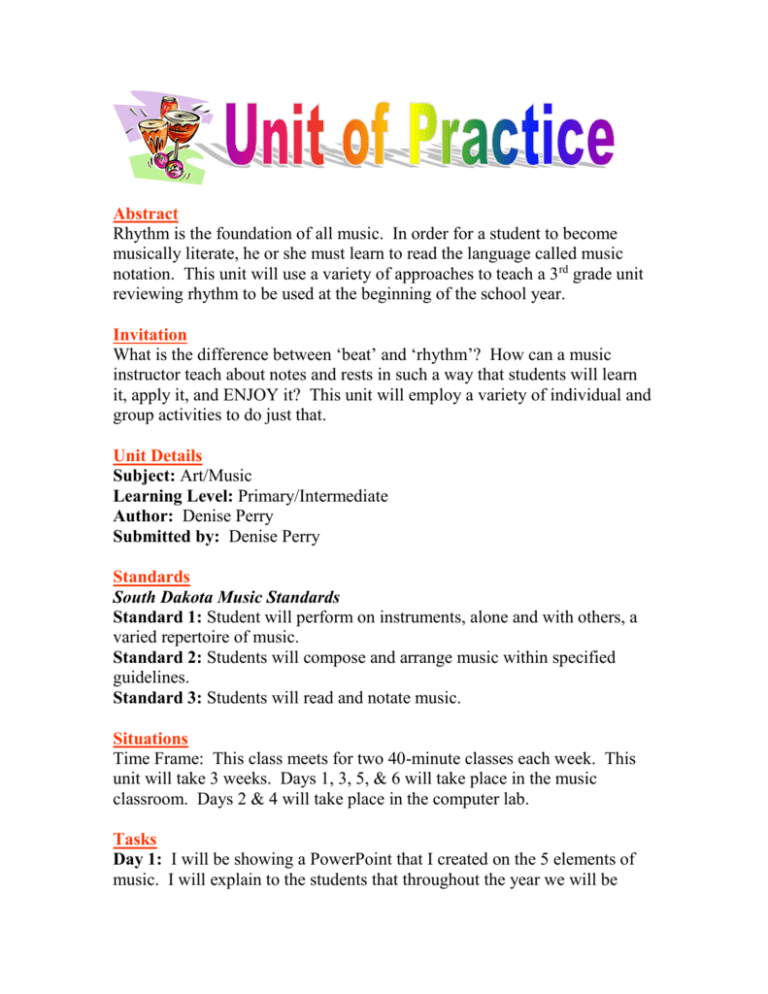
Abstract Rhythm is the foundation of all music. In order for a student to become musically literate, he or she must learn to read the language called music notation. This unit will use a variety of approaches to teach a 3rd grade unit reviewing rhythm to be used at the beginning of the school year. Invitation What is the difference between ‘beat’ and ‘rhythm’? How can a music instructor teach about notes and rests in such a way that students will learn it, apply it, and ENJOY it? This unit will employ a variety of individual and group activities to do just that. Unit Details Subject: Art/Music Learning Level: Primary/Intermediate Author: Denise Perry Submitted by: Denise Perry Standards South Dakota Music Standards Standard 1: Student will perform on instruments, alone and with others, a varied repertoire of music. Standard 2: Students will compose and arrange music within specified guidelines. Standard 3: Students will read and notate music. Situations Time Frame: This class meets for two 40-minute classes each week. This unit will take 3 weeks. Days 1, 3, 5, & 6 will take place in the music classroom. Days 2 & 4 will take place in the computer lab. Tasks Day 1: I will be showing a PowerPoint that I created on the 5 elements of music. I will explain to the students that throughout the year we will be learning about all five elements or “ingredients” of music. We will be starting with the element called RHYTHM. Ask students if anyone can remember the difference between beat and rhythm. Discover that the BEAT is steady, and the RHYTHM is uneven, having long sounds, short sounds, and silence. Play a song with a good, strong beat. Start by having students mirror me as I show the steady beat in a variety of ways. (Pat lap, tap shoulders, march in place, monkey arms, etc.) Let different students choose ways to show steady beat. Set four chairs across the front of the room. Each chair represents a beat. Have one student sit in each chair. Each student represents a sound. Ask what note shows one sound for one beat. (Quarter note) Ask for a student to clap the rhythm in the four chairs. (ta, ta, ta, ta) Write the rhythm on the board. Continue with 4-chair concept to review quarter notes, quarter rests, and eighth notes, clapping rhythms and writing them on the board. Day 2: In computer lab we will have installed the Music Ace 2 software. This day will be spent doing lesson 1 – Beat and Tempo, and lesson 2 – Hearing Rhythms. This software is set up to keep track of individual student progress. When the student has completed the lessons, there are corresponding games to reinforce the concepts taught. Day 3: I will have various 4-beat and 8-beat rhythm patterns written on the board. I will clap the rhythms and have students identify the correct pattern, then clap and say the rhythm together as a class. Next I will use Cheryl Lavendar’s Rockin’ Rhythm Raps book and CD. We will do the lessons covering quarter notes, quarter rests, and eighth notes. First we will evaluate each rhythm, calculating the number of beats and locating the various notes. Then we will clap and say each rhythm pattern along with its Rockin’ Rhythm Track from the CD. The last activity will be having each student create his/her own 8-beat rhythm, then clap it for a partner. Finally, have each student perform his/her rhythm for the class accompanied by the Rockin’ Rhythm Track. Day 4: This day will also be in the computer lab. We will be completing lesson 5 – Basic Rhythm Notation and lesson 6 – Quarter Rest. Again, when students have completed the lesson, they can play the corresponding games to reinforce the concepts taught. Day 5: Students will pick up rhythm sticks on the way to their chairs. Begin with an echo session where teacher plays four beats, and students echo. Let students create their own rhythm pattern. Have each student play his/her pattern with the class playing the echo, trying to keep the beat steady. Talk about the word “complementary.” On the board, write 3 complementary 8-beat rhythm patterns. Divide the class into 3 groups, and take turns having each group clap the different patterns. Divide into 3 person groups. Each group gets a form with places for 3 8-beat rhythm patterns with repeat signs. The remainder of class will be used for groups to write the 3 patterns. Day 6: This is the final day of the rhythm review. Let groups get together to decide who will perform each part and provide practice time. Have the groups choose 1 unpitched percussion instrument for each of the rhythms. We will perform a song in rondo form: ABACADAEA... Teach the main theme (A). Assign the groups the order of the song. Perform and record using a digital video camera. Interactions 1. Teacher-led discussion of 5 elements of music, followed by class review of beat and rhythm. 2. Students will work individually on the computer with the Music Ace 2 software. 3. Students will work in pairs to perform their 8-beat patterns created with Rockin’ Rhythm Raps. 4. Students will work in groups to create and perform complementary rhythm patterns. Assessment 1. Individual records will be tracked from student’s work with Music Ace 2 software. 2. Students will hand in individual 8-beat rhythms written during work with Rockin’ Rhythm Raps. 3. Teacher will observe student’s ability to create 4-beat pattern with the rhythm sticks. 4. Rubric will be used to determine student success writing and performing complementary 8-beat patterns. Tools 1. Teacher-created PowerPoint teaching the 5 elements of music 2. Computer and TV with necessary hook-ups 3. 4. 5. 6. 7. 8. Recorded music with a strong beat Music Ace 2 computer software Cheryl Lavendar’s Rockin’ Rhythm Raps book and CD Rhythm sticks for each student Worksheet for group project writing complementary rhythms Digital video camera For More Information Related Units Teacher Comments Related Resources

